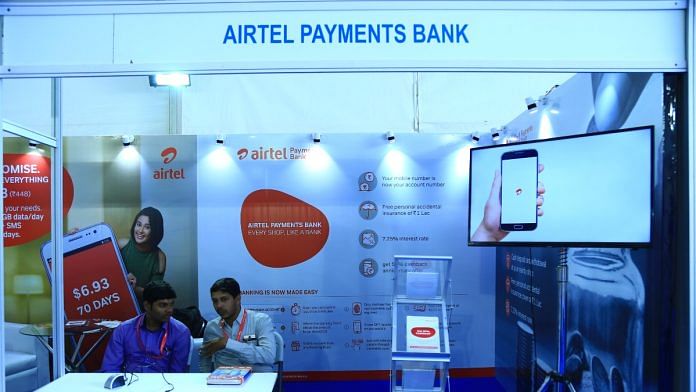Thank you dear subscribers, we are overwhelmed with your response.
Your Turn is a unique section from ThePrint featuring points of view from its subscribers. If you are a subscriber, have a point of view, please send it to us. If not, do subscribe here: https://theprint.in/subscribe/
Reserve Bank of India (RBI) set up a committee on Comprehensive Financial Services for Small Business and Low-Income Household (CCFS), headed by Dr. Nachiket Mor along with experienced members from the financial services industry with diverse backgrounds to fulfil the mission of financial inclusion. The vision was to design an electronic payment network for accessing savings by establishing payment banks (PBs). The recommendations from the committee were the key reason to issue licenses to payment banks in 2014 by the then central bank governor Dr. Raghuram Rajan. In 2024, the viability as we know of these banks is questioned and this article explores the reason. The author discovers the reasons lie in the differences in the framework and its implementation as below.
Firstly, the recommendations of CCFS included a maximum deposit of PBs to be Rs 50,000. As per the latest RBI guidelines, this has been increased to Rs 200,000 from its earlier Rs 100,000. This deviates from the core thought of the committee for establishing PBs for 60% of the economy’s population, which is from low-income households earning USD 2 per day. Higher deposits are needed by scheduled commercial banks (SCBs) for credit generation. In the absence of a lending function, PBs are targeting a different customer base from the economy. Luring customers from SCBs by providing higher interest is burdening PBs efficiency.
Another submission of the committee was to keep the balance in approved SLR securities for less than three months. The central banker has marginally changed this recommendation by asking PBs to deploy 75% of their demand deposits to G-Secs or T-bills with one year maturity and the remaining 25% in current and time deposits of SCBs. This rule is to safeguard the low-income households’ money by placing it in non-risky assets. The author suggests the investment in dated securities be around 50% for stability, 25% in SCBs as recommended and remaining 25% in other market instruments for sustainability of PBs.
Thirdly, under Basel III, the minimum Capital to Risk Weighted Assets Ratio (CRAR) required by SCBs is 11.5%, including the capital conservation buffer (CCB). CCFS suggest PBs to comply with similar guidelines and keep 15% CRAR inspite the absence of credit and market risk. Additionally, the core (Tier 1) capital requirement for PBs, stands at 7.5% against SCBs 7%. These higher capital requirements increase the borrowing cost for PBs which could have been otherwise used for operations.
Fourth, the committee recommended that payment banks can avail priority messaging (SMS) service at reasonable rates. [1] The central banker along with Telecom Regulatory Authority of India (TRAI), will discount mobile banking services for PBs, to boost the reach of their transactions as well as products. RBI’s payment bank guidelines do not mention this critical recommendation. Awareness, lack of trust, and lack of perceived need are the chief factors for low PB adoption by migrant labour, and small vendors. [2] The discounted usage of priority SMS by PBs will create awareness which is immensely required for financial inclusion.
Currently PBs need strong marketing for its customer reach and eventual growth. Both the committee and central banker discuss the use of Business Correspondents (BC), who are the distribution network of the chain. However, there is less deliberation on the primary step in the banking value chain i.e., marketing and sales. Out of the 120 crores of phone users, only 60 crores have a smartphone in India. PBs should target this market for awareness creation in Tier V and VI regions and create the business plan for financial inclusion.
Sixthly, the committee had explicitly mentioned that the licenses should be given to the existing 27 prepaid payment instruments (PPIs). These PPIs were authorized under Payment and Settlements Act (PSA) of 2007, which provided the low value payment services to the unbanked population. However, the licensees are using this platform as a stepping stone for building expertise and eventually get into mainstream banking. [3] The current discussion by the central bank about permitting the payment banks to apply for a small finance bank license after a period of five years defeats the purpose of differentiated licensing of CCFS.
Lastly, the advent of the Unified Payment Interface (UPI) in 2016 shattered the dreams of the payment bank licensees, and the sustainability of the business model came into question, which made a few players leave the market, among other reasons. The interoperability, security, cashback, simple interface, and inequitable competition for UPI made this payment system take over the financial industry by storm. [3] But in spite of the 93% jump in UPI transactions since its inception, usage of UPI in rural India is just about 3-7%.[4]
India’s 190 million unbanked population needs a unique financial institution to integrate all into the formal economy. Payment banks can become sustainable if the committee recommendations are implemented in the spirit of differentiated licenses, by making further enhancement for financial inclusion and lastly by creating a level playing field in the market competition.
These pieces are being published as they have been received – they have not been edited/fact-checked by ThePrint.


